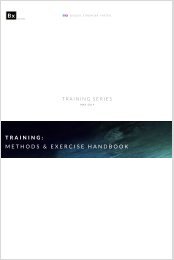You also want an ePaper? Increase the reach of your titles
YUMPU automatically turns print PDFs into web optimized ePapers that Google loves.
HTKSPORT<br />
Traditional strength training is not optimal for speed athletes because such training<br />
methods usually employ slow and sustained applications of force (DUR). Instead<br />
speed athletes rely predominantly on the elastic potential of their muscles for<br />
maximal force application (see above), and therefore must have a base of absorption<br />
strength rather than traditional contractile strength. ‘Strength’ may therefore be used<br />
to described different physical outputs. Strength may refer purely to maximal force<br />
output. In training terms this usually means overcoming strength – simply moving a<br />
given weight or resistance. The greater the resistance, the greater the amount of<br />
overcoming force is required to displace that weight. This is essentially an expression<br />
of absolute strength, and is more commonly referred to as a one-rep max. The term<br />
‘rep’ in this context may reference a lifting movement (like a squat or deadlift), or<br />
shifting a static resistance for a given distance (such as some strongman events).<br />
Strength may also be used to describe the dynamic application of force, ranging in<br />
outputs from strength-endurance (sub-maximal force for extended periods of time)<br />
to explosive strength/strength-speed (applying force with speed).<br />
HYPERTROPHY<br />
Muscle hypertrophy is essentially an expression of ‘strength endurance’. As we have<br />
seen, and is demonstrated even further below through an example, while the actual<br />
expression of hypertrophy-specific training is DUR work, it shouldn’t be forgotten that<br />
the potential of that training is greatly increased by improving MAG ability, which is<br />
typically characterised as strength-speed work.<br />
ENDURANCE<br />
Finally, the muscular performance aspects of ‘endurance’ may be loosely defined<br />
under strength endurance, but this quality is usually (to various extents depending on<br />
the exact endurance demands) dependent on cardiovascular qualities. These are not<br />
the focus of this book.<br />
How, then, do we categorise activity types to reflect the various neuromuscular<br />
inputs?<br />
17<br />
This is the focus of the next Part of this book.<br />
JUNE 2018 | ISSUE 01




